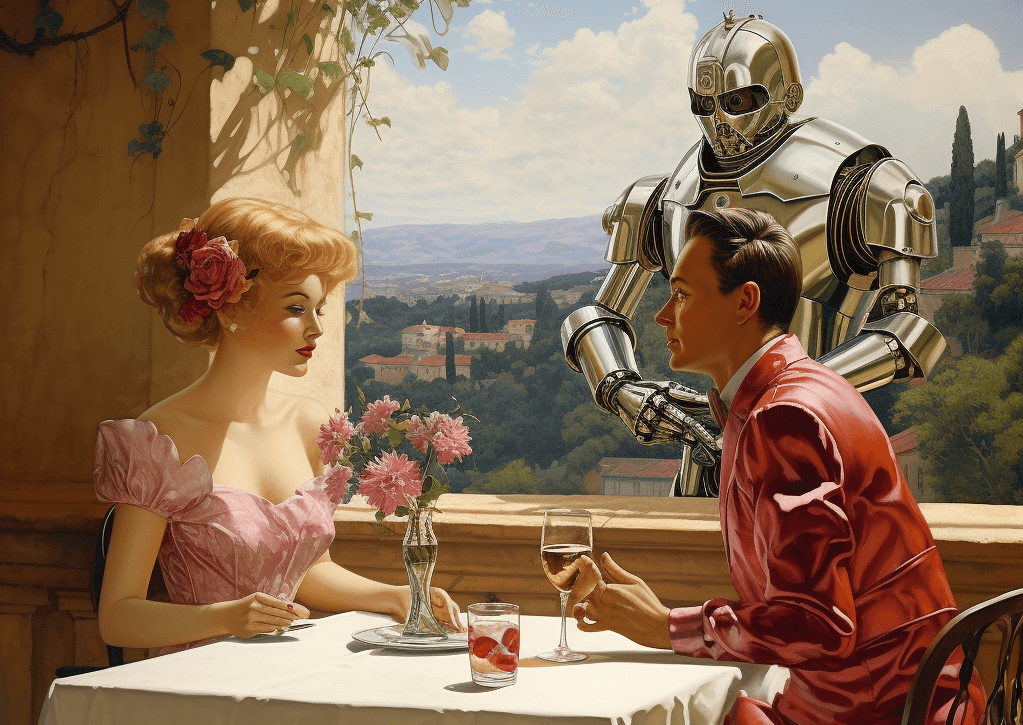Digital dining with a chatbot: AI hits the hospitality industry
27 June 2023
Since the launch of OpenAI’s ChatGPT beta in November 2022, the LLM (Large Language Model) chatbot race has heated up in 2023. We saw Google Bard go head to head with Microsoft and OpenAI, and the ChatGPT API usher the chatbot into a more practical phase. Now, regulatory bodies are stroking their chin about balancing safety with innovation.
In this post-ChatGPT revolution, the bar has been raised for great personalised services. The transformative potential of the tech has arrived and annihilated excuses for a bad customer experience (CX) – and employee experience, too. Even just before ChatGPT, it was reported that 76% of restaurants currently use 3 or more automated tools.
A robot in a waiter uniform whizzing to your table might not be the future of hospitality, but some well-placed digitisation is due. In this article, we bring you up to speed about how generative AI is levelling up the hospitality industry, focusing on restaurants. The goal is for the repetitive tasks that come with managing bookings to be lifted from restaurant personnel’s shoulders, freeing them up to add human value where it matters.
We also sit down with the founders of food and restaurant tech companies yetipay and Foodpairing to gather their insights on how AI technology, including their own, is shaping the future of hospitality
How restaurant chatbots might look: an overview
The aim of restaurant chatbots is to automate repetitive tasks performed by human staff, enabling restaurants to cut operational costs. For years, simple (as we call them “rule-based”) chatbots have been used for bookings, orders, deliveries, enquiries, and payments. Customers and restaurants have loved the the 24/7 availability, the promotion of deals, the collection of contact details for receipts, surveys and marketing. But while these chatbots “got the job done”, they very rarely sparked any joy.
With ChatGPT’s release, and consumer expectations quickly raising the bar (no pub intended), we anticipate a shift away from rule-based chatbots (rigid, pre-programmed answers, unadaptive, not very “human”), and towards more sophisticated, human-like chatbots that are underpinned by Natural Language Processing (NLP) and trained on Large Language Models (LLMs) like ChatGPT/GPT-4.
This next generation of chatbots can truly deliver an exceptional experience. It can, for example, learn from their interactions with customers, so can recognise regular customers and automate loyalty programmes. Voice recognition and speech-to-text bots will also become prevalent, for example in drive-throughs – Wendy in the US is already in a live ChatGPT trial – or even simply voice-enabled Deliveroo orders, executed via Alexa. We’re just 1 ChatGPT plugin away from that today!
The ideal chatbot will adapt and filter the menu based on your dietary requirements with greater knowledge and speed, and less (potentially fatal in the case of allergens) human error, than hailing a waiter or phoning a busy, noisy restaurant. This reality could look like the following.
Famished on a Tuesday evening, you whip out your phone to check out nearby options for dinner. You consider a Thai place a few blocks away. It’s peak hours, so you know better than to phone them, but you can’t ask clarifying questions to an FAQs page.
Instead, you open a chat through either the website’s “interactive menu” button, Whatsapp, Messenger, social media like Instagram, or a table-booking app, and say out loud:
“Do you cater to vegans?”
“We have plenty of delicious vegan options. Tell us about what kind of food you like and we’ll shoot you some recommendations.”
“I’m not very good with spice, but I like creamier dishes. I’d like something that comes as a large portion size.”
“Amazing – we are great at adapting our dishes to be less or more hot. In particular, we recommend our milder version of our Green Thai Curry with tofu or vegetables, with extra rice.”
“Cool, I’d like a table for two at 20:15 today.”
This has been in evolution for several years. OpenTable integrated with Alexa in 2017, giving diners the ability to make reservations as easily as saying “Alexa, ask OpenTable to make me a reservation”. Pizza Hut announced a chatbot reachable through Messenger as early as 2016 – a move to catch the next generation at a time when phone call orders were still the norm.
Front of house chatbots: introduction
In the above example, we saw a chatbot handle table booking and enquiries. To continue with the front-of-house domain, let’s examine table service, self-service, drive-throughs, and paying the bill. Interactive interfaces will crop up on restaurant tablets and customers’ phones (QR codes and apps).
Chatbots are a natural evolution in making fast food in particular even faster. In fact, one survey of restaurant leaders showed that the majority consider drive-through operators and hosts to be replaceable with today’s automation technology.
In the UK, we suspect that economical, high-volume chains will be the frontrunners, given their taste for experimentation. McDonalds’ gigantic self-service touchscreens in every branch are already the presumed way to order. Wetherspoons’ app has a fun gifting feature that allows users to send food and drinks to their friends’ table from afar.
Front of house chatbots: paying the bill
First, let’s take a look at payment. One-third of consumers stated a preference for digital channels for paying the bill. We envision that chatbots accessible through social media and messaging apps and QR codes will outshine distinct apps rolled out by different restaurants.
Through Facebook Messenger, you can speak with a chatbot that arranges payment. Fintech company Adyen has teamed up with Flyt (part of the JustEat group) to make this possible. The fact that Messenger’s 1.3 million monthly active users worldwide do not need to download a new app is an attractive factor – especially for those of us lacking data or phone storage.
There are downsides to using a centralised app like Messenger instead of, say, Wagamama’s own app, for payments and tips: customer data is a valuable resource for business analysis.
Front of house chatbots: drive-through
Wendy’s innovation has been in the limelight. This month, the fast-food chain was revealed to be working with Google to automate its drive-through.
Using Google’s LLM, Wendy’s is rolling out a “very conversational” chatbot that customers can speak to from the car. It’s no mean feat to get it right – the algorithm is tasked with detecting various accents, dialects, and acronyms, all potentially with the backdrop of a noisy car. If all else fails, customers have the option of human fallback.
To yetipay's Oliver Pugh voice chatbots are appropriate for drive-throughs, but not the dinner table. Drive-throughs, even when human-operated, are “talking out of your car into a box in the wall”, explains yetipay's Pugh. “But dining at a table is different.” yetipay's product is a table-top card reader for paying and tipping.
“At one point, we tried to capture feedback via voice, but people didn’t want to speak to the device at the table”, continues Pugh. “I don’t see a world, at least in the foreseeable future, where we will talk to chatbots at a sit-down meal, neither voice nor typing.”

Image generation with AI
ChatGPT might be the more famous sibling in OpenAI’s family, but text-to-image tools like DALL-E (the platform we use to generate awesome images for our blog posts!) are also in the news (think of how an AI-generated image of an explosion near the US Pentagon went viral last month).
An image preview of a plate piling high with food that the customer has put in their basket could materialise on the self service screens of tomorrow. Images could be created for menus, which could convince customers to order more from restaurants, some speculate. Lunchbox and SWIPEBY are two startups using OpenAI’s offering to generate food images. Lunchbox works with about 200 brands, and it uses OpenAI’s DALL-E.
AI for business intelligence and recipe innovation
Some uptake of AI is far from the dining table and in the office. AI is being used for new product development (NPD) by gastronomy innovation consultancies, data platforms and biotechnology companies like Makeat, Tastewise, NotCo, and Climax Foods. Further, customer data and behaviour analysis can be used to offer personalised recommendations, deals, and promotions.
Recipe innovation is certainly getting very intelligent with AI. NotCo has developed an algorithm with the ability to find infinite combinations of plants to replicate animal products – this is a great example of AI being used as a force driving sustainability. Foodpairing is a startup that analyses food ingredients to identify which pair well together. The team speaks to us about how it uses its own generative AI, rather than ChatGPT.
“We don't see Chatgpt as a threat. The flavour suggestions it makes are very limited,” co-founder Bernard Lahousse says to Springbok. “It seems impressive when you start to use it, but once you use it multiple times it is very repetitive and you cannot rely on the answer.
“Our value proposition is the data consolidated in our knowledge graph and the models using analytical data to make predictions. There’s no way ChatGPT can say what fits a specific product, new product or future product, whereas we can. Each day, we add a hundred new products to our database. We can virtually create new flavour profiles and predict their pairing, liking, buying intent.”
Despite this, on the Springbok view it is likely that companies like Foodpairing will nonetheless use ChatGPT to deliver the final recommendation, once the information has been retrieved.
Tastewise is one example of an AI-driven data platform that answers questions like “which recipes will increase retail sales?”, and “which restaurants should you sell your plant-based products to?”. It bases its decision-making on billions of real-world eating and drinking moments pulled from global data sources including social media and restaurants' menu items.
To accompany the recipes, a generative AI tool could plausibly be developed that writers succulent descriptions for menus. It could work by a restaurant uploading an image of the dish along with an ingredients list.
We can also expect AI-generated animated faces to accompany audio chatbots’ AI-generated voices, though this might be unsettling until the technology is refined (or even when it is spot on!).
Conclusion
On one end of the spectrum is the traditionalist take. “If there’s any sector I hope they’re careful about transforming with AI, it’s hospitality. Sitting down for a meal is about people, it’s about connection,” says yetipay founder Oliver Pugh. “I spend all day looking at screens,” says Pugh. “I go to a restaurant to relax, I don’t want to look at a menu on my phone.”
In the Springbok view, well-placed automation can actually mean more time for those convivial, winding-down moments that we all treasure. Precious time is wasted in hospitality through human error (commonplace for busy waiters juggling multiple tables!), language barriers, lack of 24/7 support, and waiting for service. Paying with a chatbot, by contrast, can take just 45 seconds.
If you’re interested in anything you’ve heard about in this article, reach out at victoria@springbok.ai.
Other posts
Linklaters launches AI Sandbox following second global ideas campaign
Linklaters has launched an AI Sandbox which it says will allow the firm to quickly build out AI solutions and capitalise on the engagement and ideas from its people.
Linklaters staff pitch 50 ideas in supercharged AI strategy
Linklaters has announced the launch of an AI sandbox, a creative environment that will allow AI ideas to be brought, built and tested internally.
Linklaters joins forces with Springbok for its AI Sandbox
Global law firm Linklaters has launched an ‘AI Sandbox’, which will allow the firm to ‘quickly build out genAI solutions, many of which have stemmed from ideas suggested by its people’, they have announced.




